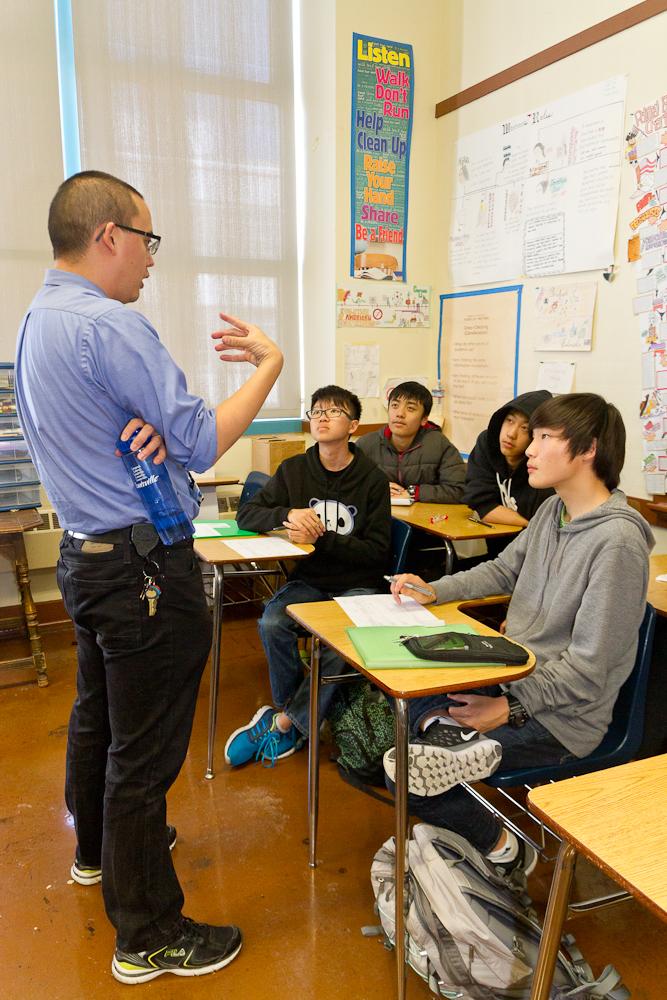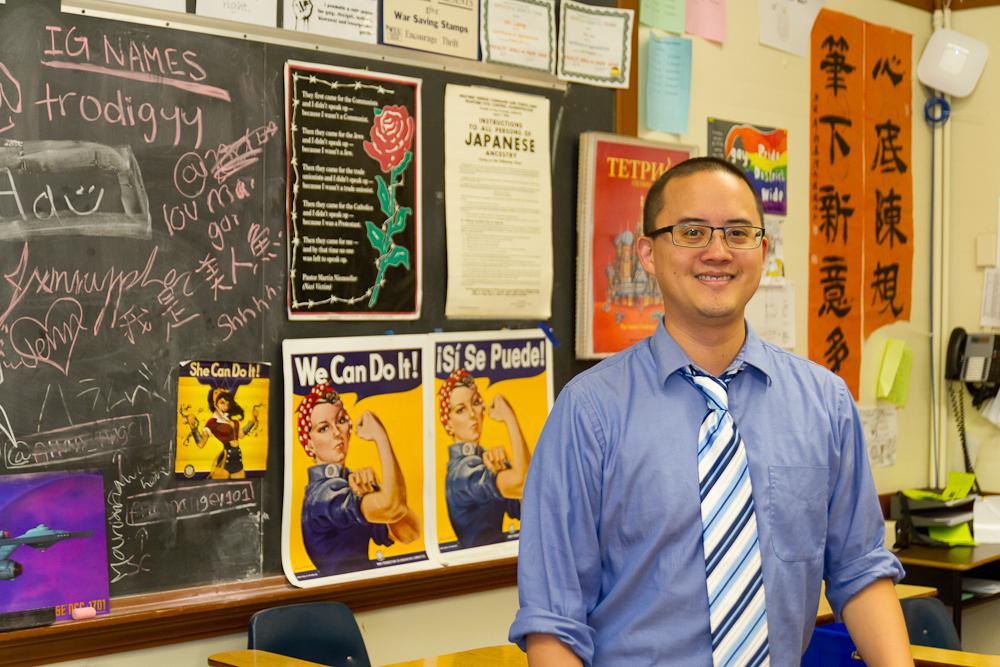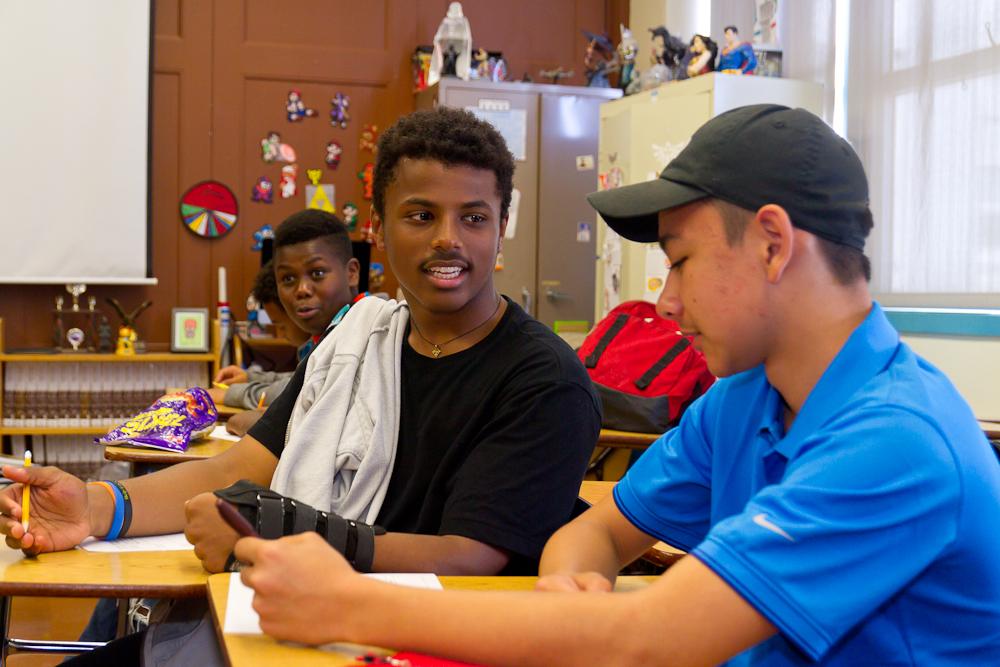California will soon provide ethnic studies classes for all high schoolers. Here’s why.
Freshmen Yoni Fisseha (left) and Ethan Elejorde in class at Washington High School in San Francisco. Fisseha says he didn’t know about his parents’ immigration story until he had to complete an assignment in their ethnic studies class.
In a second-floor classroom at San Francisco’s Washington High School, David Ko is leading freshmen in a discussion about bullying. But it’s not the typical conversation about treating others nicely.
“We’re learning about power — political, economic, social — our race, ethnicity, culture, nationality,” says 14-year-old freshman James Liu.
That’s because ethnic studies is not simply a history course detailing the achievements of members of different racial groups; the curriculum is conscious of and sometimes analytical about how race and ethnicity are intertwined with power.
Earlier this fall, California Governor Jerry Brown signed into law a bill that will, by 2019, create an ethnic studies program for all of the state’s public high schools. Three similar bills failed in recent years, over lack of funding or concerns that they would create additional red tape.
Ko’s class, which he describes as a good representation of Washington High’s diversity — 64 percent Asian, 13 percent Hispanic, 8 percent white and 5 percent African American — engages in weighty and sometimes personal discussions. Earlier this year, for example, they had a conversation about changing their school’s name because its namesake, George Washington, was a slave owner.
“Some students got very emotionally charged and moved by it,” says Ko. “We were able to have that discussion and at the end of the class period no one was calling anyone names, there weren’t grudges held, people didn’t throw any punches.”

Classes like this one are taught at almost all of San Francisco Unified’s 19 high schools. Washington was one of the first campuses to offer ethnic studies in a pilot program, beginning eight years ago. Two years ago, San Francisco expanded the program across the city.
Now a committee of teachers, professors, community members and students will spend the next two years developing an ethnic studies curriculum that will be taught across the state. It’s not as simple as replicating San Francisco Unified’s lessons. In San Francisco, ethnic studies is a ninth grade class that includes the histories of minority groups — including Black, Latino and Asian Americans — as well as curriculum about how race may affect power and opportunity. In other schools, such as in Los Angeles, courses might be focused on one topic, such as African American history or Mexican American literature. Currently, 20 California school districts already teach ethnic studies or are in discussions to add them.
San Francisco’s courses may be a good example of what other classes in California may look like, although organizers want to leave enough flexibility to tailor the lessons to the needs in different parts of the state. R. Tolteka Cuauhtin teaches ethnic studies at the Social Justice Humanitas Academy, a high school in the Los Angeles Unified School District. Cuauhtin is also part of Ethnic Studies Now, a coalition of teachers and professors which pushed for the statewide change.
“How can we ensure that it is not diluted, made uncritical, and devoid of what it really needs to be transformational for students?” asks Cuauhtin. “Just carrying the name ‘ethnic studies’ isn’t enough for it to produce the transformational results that it’s been demonstrated to be capable of.”
Ethnic studies programs have been at the center of controversies in other states. Arizona banned ethnic studies in 2010; critics said that the curriculum encouraged the overthrow of the US government and promoted resentment towards certain groups. In November, the Texas State Board of Education rejected a Mexican American studies textbook, which many scholars said was inaccurate or worse, racist.
Also: US classrooms are becoming an unlikely immigration battleground
A study released earlier this year by Stanford University shows that ethnic studies classes have many long-term benefits for students, including fewer absences, higher grades and even better graduation rates. Those improvements were especially pronounced among boys and Hispanic students. San Francisco Unified intentionally made ethnic studies a freshman course with the aim of impacting students early, and keeping them in school.

“If the class is only available to seniors, there would be some students in the ninth grade who are not at Washington or perhaps even in school by the time they get to be seniors,” says Ko, who himself is a 2000 graduate of Washington High. “This was the kind of class that I really would have benefitted from.”
In his sixth period ethnic studies class, Ko describes a scenario about a person getting bullied, then standing up for himself. He asks the class what type of racism this qualifies as. Students start yelling out answers. A quiet 14-year-old named Mariana Marin lifts her hand, offering an answer: “Interpersonal?”
When I ask her after class if she likes school, Mariana answers, “No, but this is the exception, I guess.”
Other students in the class tell me over and over that they’ve learned things that help them understand their world.
“I didn’t know that both of my parents came here 25 years ago,” says 13-year-old Yoni Fisseha, the son of Ethiopian immigrants. “They told me that when I was writing my essay for this class.”
Students and teachers of ethnic studies in California say the courses are not meant for one specific group, but to better understand intersectionality — how factors such as race, class and gender may overlap and add up, creating an uneven playing field for marginalized groups.
“I think it’s for everyone,” says 14-year-old Ethan Elejorde. “It’s for everyone to learn about each other.”
History: How a Lebanese immigrant helped pave the way for ethnic studies
And now, in this post-election climate — teachers surveyed by the Southern Poverty Law Center overwhelmingly say harassment, hate and anxiety have increased in classrooms — ethnic studies organizers have faith that California can lead the way in a better understanding of race and its role in society.
“We remain resolute,” says Cuauhtin.
There are still details to work out with the state education commission in charge of curriculum: how will the programs will be funded and will the classes be required for graduation? In the meantime, Cuauhtin and a group of other high school teachers, college faculty and community members will continue to develop the ethnic studies lessons, which could be in schools as soon as 2020.
2014-2015 was the first school year when students of color outnumbered white students in public kindergarten through 12th grade classrooms. Here are more stories about the evolution of education in America.
Every day, reporters and producers at The World are hard at work bringing you human-centered news from across the globe. But we can’t do it without you. We need your support to ensure we can continue this work for another year.
Make a gift today, and you’ll help us unlock a matching gift of $67,000!
